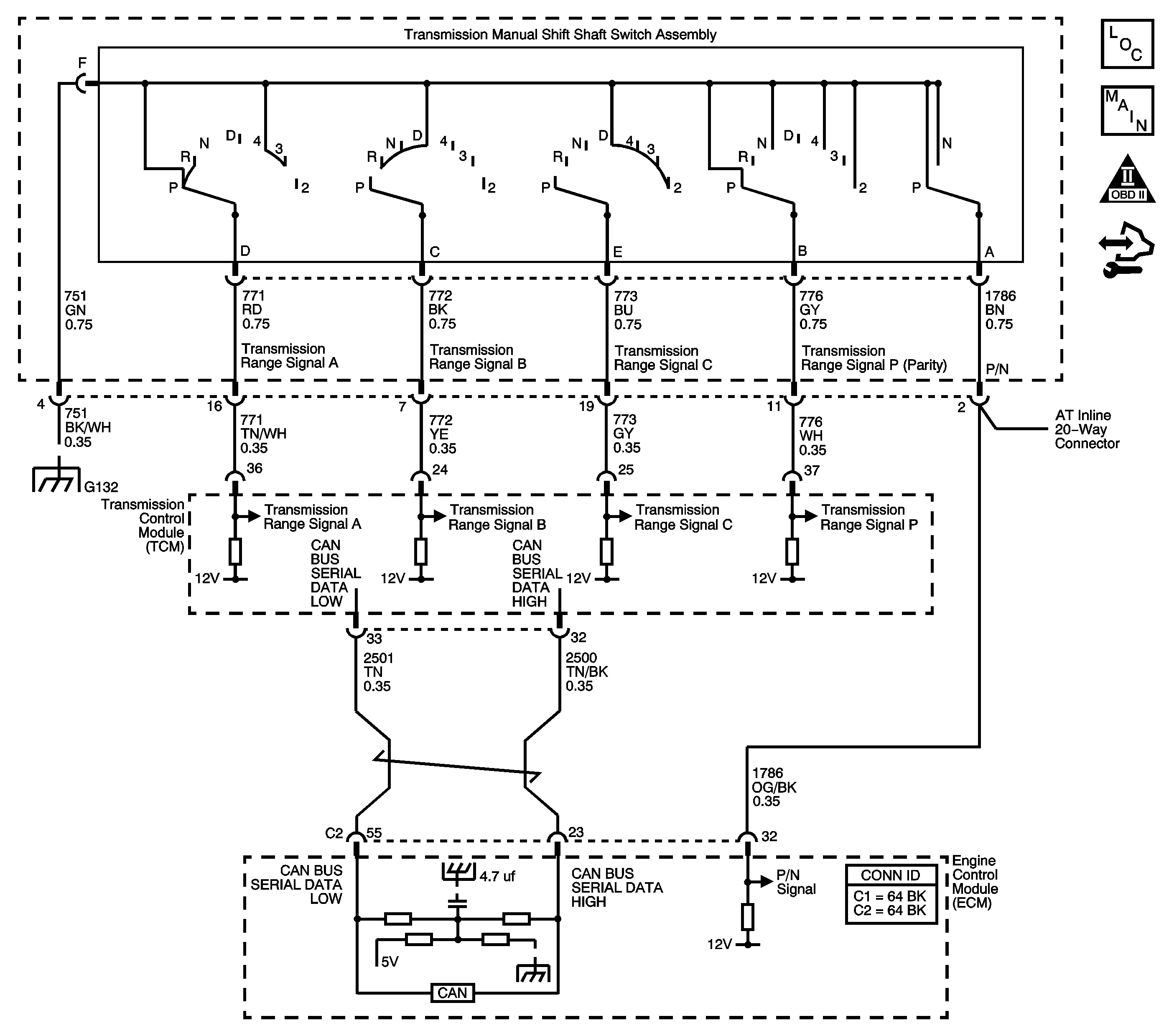
Circuit Description
The transmission manual shift shaft switch assembly is a sliding contact switch attached to the control valve body within the transmission. The 4 inputs to the transmission control module (TCM) from the switch indicate which position is selected by the transmission selector lever. This information is used for engine controls as well as determining the transmission shift patterns. The input voltage level at the TCM is high when the switch is open and low when the switch is closed to ground. The state of each input is displayed on the scan tool as IMS. The 4 IMS input parameters represented are Signal A, Signal B, Signal C and Signal P (Parity).
If the TCM detects switch Signal C is high while the vehicle is being driven in a forward gear, then DTC P1826 sets. DTC P1826 is a type B DTC.
DTC Descriptor
This diagnostic procedure supports the following DTC:
DTC P1826 Internal Mode Switch C Circuit High Voltage
Conditions for Running the DTC
| • | No OSS DTCs P0722 or P0723. |
| • | No engine torque signal DTC P2637. |
| • | Vehicle speed is greater than 8 km/h (5 mph). |
| • | Engine torque is greater than 20 N·m (15 lb ft). |
| • | DTC P1826 has not passed during the current ignition cycle. |
| • | The gear ratio is within one of the following ranges: |
| - | 3.33:1 to 3.50:1 for first gear |
| - | 2.16:1 to 2.27:1 for second gear |
| - | 1.56:1 to 1.64:1 for third gear |
| - | 0.98:1 to 1.03:1 for fourth gear |
| - | 0.73:1 to 0.77:1 for fifth gear |
Conditions for Setting the DTC
The TCM detects Signal C is high, while the gear ratio indicates first, second, third, fourth, or fifth gear for 3 seconds.
Action Taken When the DTC Sets
| • | The TCM requests the ECM to illuminate the malfunction indicator lamp (MIL) during the second consecutive trip in which the Conditions for Setting the DTC are met. |
| • | The TCM commands maximum line pressure. |
| • | The TCM freezes transmission adaptive functions. |
| • | The TCM assumes a D5 shift pattern. |
| • | At the time of the first failure, the TCM records the operating conditions when the Conditions for Setting the DTC are met. The TCM stores this information as a Failure Record. |
| • | At the time of the second failure, the ECM records the operating conditions when the Conditions for Setting the DTC are met. The ECM stores this information as a Freeze Frame. |
| • | The TCM stores DTC P1826 in TCM history. |
Conditions for Clearing the DTC
| • | The ECM turns OFF the MIL after the sixth consecutive drive trip in which the TCM does not send a MIL illumination request. |
| • | A scan tool can clear the DTC. |
| • | The TCM clears the DTC from TCM history if the vehicle completes 40 warm-up cycles without a non-emission related diagnostic fault occurring. |
| • | The TCM cancels the DTC default actions when the ignition is OFF long enough in order to power down the TCM. |
Test Description
The number below refers to the step number on the diagnostic table.
Step | Action | Value(s) | Yes | No | ||||
|---|---|---|---|---|---|---|---|---|
1 | Did you perform the Diagnostic System Check - Vehicle? | -- | Go to Step 2 | |||||
2 |
Important:
Does the scan tool IMS range indicate Drive 5? | -- | Go to Testing for Intermittent Conditions and Poor Connections | Go to Step 3 | ||||
Refer to Automatic Transmission Inline 20-Way Connector End View . Does IMS Signal C indicate LOW? | -- | Go to Step 5 | Go to Step 4 | |||||
4 | Test the TR signal C circuit of the transmission manual shift shaft switch assembly for an open between the TCM connector and the AT inline 20-way connector. Refer to Testing for Continuity and Wiring Repairs . Did you find and correct a condition? | -- | Go to Step 9 | Go to Step 8 | ||||
5 | Test the TR signal C circuit of the transmission manual shift shaft switch assembly for an open between the AT inline 20-way connector and the switch. Refer to Testing for Continuity . Did you find the condition? | -- | Go to Step 6 | Go to Step 7 | ||||
6 | Replace the automatic transmission wiring harness. Refer to Transmission Internal Electrical Harness Replacement . Is the action complete? | -- | Go to Step 9 | -- | ||||
7 | Replace the transmission manual shift shaft switch assembly. Refer to Manual Shift Shaft Position Switch Replacement . Is the action complete? | -- | Go to Step 9 | -- | ||||
8 | Replace the TCM. Refer to Control Module References for replacement, setup and programming. Is the action complete? | -- | Go to Step 9 | -- | ||||
9 | Perform the following procedure in order to verify the repair:
Has the test run and passed? | -- | Go to Step 10 | Go to Step 2 | ||||
10 | With the scan tool, observe the stored information, capture info and DTC info. Does the scan tool display any DTCs that you have not diagnosed? | -- | System OK |
